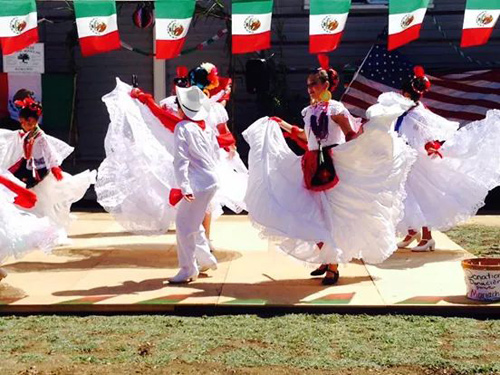Mon 15 Sep 2014
Grito de la Independencia in Point Reyes Station
Posted by DavidMitchell under Point Reyes Station
[2] Comments
Mexico’s Independence Day was celebrated Sunday in Point Reyes Station with mariachis, singing, folkloric dancing, Mexican food, Mexican drinks, and children’s art, all outdoors at the West Marin Commons.
Ballet Folklorico of Petaluma Paquiyollotzin provided a visual treat, thanks not only to their dancing but also to their colorful costumes. _______________________________________________________________
 Ballet Folklorico’s director, Abraham Solar, said that the group’s name Paquiyollotzin means “joyful heart” in the Nahuath language.
Ballet Folklorico’s director, Abraham Solar, said that the group’s name Paquiyollotzin means “joyful heart” in the Nahuath language.
Roughly 1.5 million people, mostly in Central Mexico, speak Nahuath. Or so I read.
Informally, the Nahuath language is sometimes called Aztec.
The four photos of dancers used in this week’s posting were contributed by director Solar. _____________________________________________________________
Drinks for sale ranged from beer and soda to such Mexican specialties as michelada and horchata.
Getting warm applause from the crowd was the band Mariachi Jalisco de Miguel Orozco.
Gilberto Rodriguez (right), who is in charge of specialized maintenance at West Marin School, and John Littleton of Point Reyes Station, who’s known for his wildlife photography, indulged in some spontaneous wrist wrestling at the food booth. To their left, Socorro Romo, West Marin Community Resource Center’s manager, was unaware of all the grimacing only an arm’s length away. ____________________________________________________________
 Mexicans refer to their independence day as Grito de Dolores (“Cry of Dolores”) or El Grito de la Independencia (“Cry of Independence”).
Mexicans refer to their independence day as Grito de Dolores (“Cry of Dolores”) or El Grito de la Independencia (“Cry of Independence”).
It marks the beginning on Sept. 16, 1810, of an 11-year-long war that achieved independence from Spain.
The “cry” was made by a Catholic priest, Miguel Hidalgo, who standing outside his cathedral in the town of Dolores exhorted Mexicans to revolt against the Spanish.
I visited Dolores (now called Dolores Hidalgo) in 2006 and was much impressed by the town’s garden-like plaza and Spanish Colonial buildings. The old cathedral still stands, and I thought: what a charming place for launching a revolution. _____________________________________________________________
A young lady at the art table with a butterfly (una mariposa) decorating her face.
A folkloric dancer twirling at one corner of the West Marin Commons, a once-vacant lot that’s evolving into a park, at the west end of Point Reyes Station’s main street. In the background is the Palace Market.
The sun was warm, and the people had a good time. It was a perfect afternoon. Or speaking in the spirit of the day: el sol era cálido, y la gente pasa un buen rato. Fue una tarde perfecta.







Dear Dave,
It’s great that you mention the Mexican Independence celebration in Point Reyes Station. More celebrations like this are taking place in the area, allowing immigrants and their children to express their traditions and somehow feel included in a land they consider strange, even though once it was theirs. Understandably, things are not always following the traditions, either because Mexicans don’t remember things very well (sometimes, being “helped” by some nice Americans,) or they have to accommodate to the American ways. For instance, the main Mexican Independence celebration is the night of September 15th. when all officials, starting by the president, and followed by governors, mayors, etc. “cry” from the balcony of the “Government Palace”(each city and important town has one) in the way Hidalgo was suppose to do in the early morning of Sep 16th.
Like other years, the celebration here was on Sep. 13th. The irony is that that date, Mexicans commemorate the end of Mexican-American War in 1847, and the battle of Mexico City’s Chapultepec Castle. Mexican forces, made up in part by young cadets, were defeated by the invader American army commanded by General Winfield Scott. At the end, Mexico lost about half of its territory (California, Nevada, New Mexico, Arizona, parts of Colorado and Wyoming, plus Texas lost earlier), forcing Mexico to sell it for 15 million dollars (half of it was offered before the war.)
The irony is that Mexican independence is celebrated here the date Mexico lost half of its territory in an ominous war nobody remembers (the invasion of a weak country in a kind of conquest to expand US territory coast to coast) in California, one of the lost territories. In any event, here in California we should celebrate Mexican independence (not 4th of July), since this was a Spanish colony, ultimately liberated by Mexicans and then becoming Mexico, until US took it by force. Interesting, isn’t?
Victor
Great photos and coverage. Looks like a wonderful event.